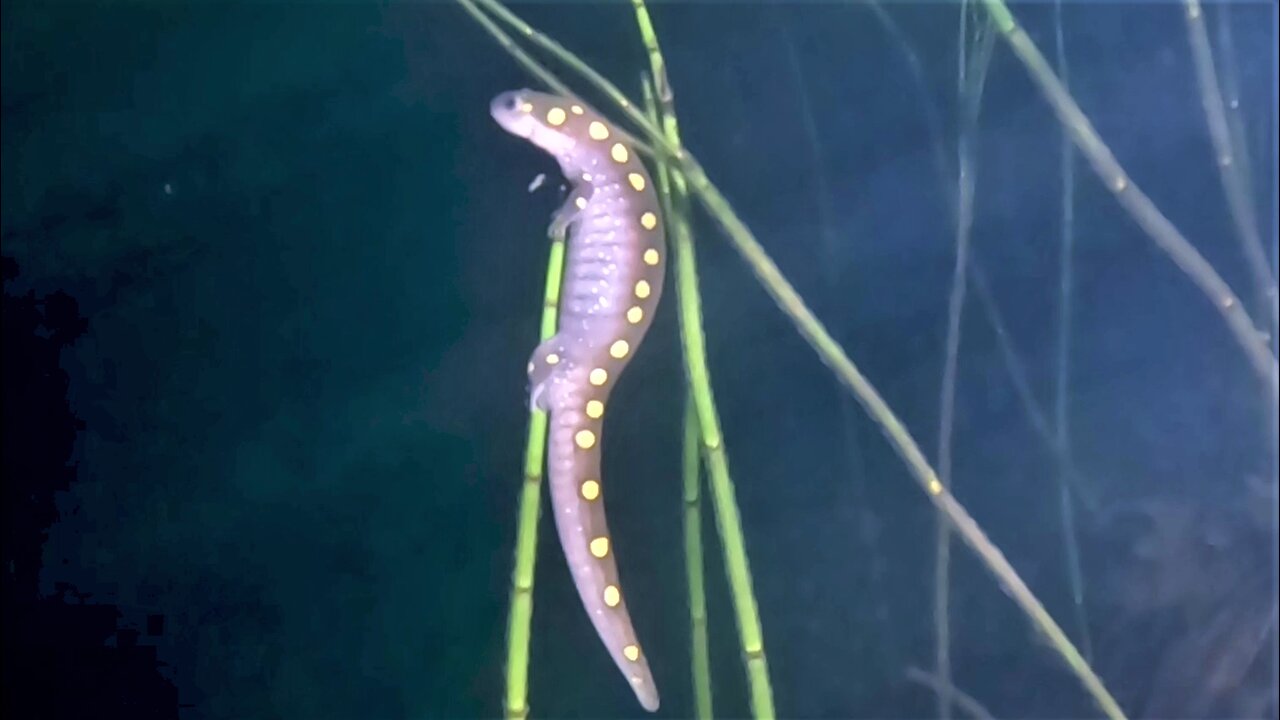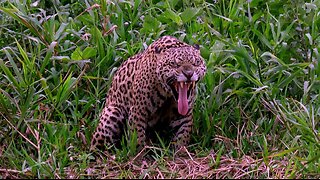Premium Only Content

Salamander lays eggs in secluded forest pond
Yellow spotted salamanders are a rare sight. Although there are great numbers of them in the area surrounding vernal pools in many forests throughout North America, they spend most of their lives burrowed underground. It is rare to catch a glimpse of one out in the open.
But each year, shortly after the ice melts on ponds like this one, the salamanders migrate here in droves, ready to mate and lay eggs underwater. The males arrive first, dropping their spermatophores on the submerged leaves. The females come next, picking up the clusters and taking them into their bodies where the eggs will be fertilized. She then selects a stalk of vegetation or a stick to attach the eggs to.
This videographer went to the local pond each night to watch the salamander migration, the mating frenzy, and the egg laying. It takes place each spring over the course of several days. This female gripped a plant stalk and lay her eggs over the course of 2-3 hours. The eggs emerged and clung to the stalk where they will remain for 6-8 weeks until they hatch.
After the mating is all over, the salamanders leave the pond as abruptly as they arrived. They go back to their refuge under the leaves or the soil, living a solitary life, feeding on worms and insects, until it is time to gather again next spring.
Spotted salamander eggs hatch in 4-8 weeks. The eggs are incredibly unique. The female lays two specific types. In one cluster, the gelatinous mass is a water soluble protein that allows oxygen and carbon dioxide exchange as the embryos develop. The other part of her cluster is surrounded by a gelatinous mass that is made up of a crystalline hydrophobic protein. It inhibits oxygen exchange but these eggs share a symbiotic relationship with an algae that grows within the eggs. The algae produces energy and oxygen through photosynthesis that the embryos use. The carbon dioxide produced by the embryos is consumed by the algae, as is the ammonia produced within the egg. This is the waste product that would harm the eggs. This is the only known true symbiotic relationship between an algae and a vertebrate animal. It is believed that the two types of egg masses will ensure survival in the presence of predators such as wood frogs. The wood frogs will not consume both types of eggs.
Spotted salamanders play an important role in the food chain as they are a major source of food for foxes, raccoons and other forest dwellers.
-
 1:18
1:18
WildCreatures
1 month ago $2.91 earnedTourists unintentionally come face to face with jaguar in Brazil's Pantanal
15.9K17 -
 LIVE
LIVE
Robert Gouveia
2 hours agoNewsom Crushed AGAIN!! NBA Arrests! NEW Pipe Bomber Info! Melania SUED!
480 watching -
 LIVE
LIVE
Sean Unpaved
1 hour agoHoops & Handcuffs: FBI's Mafia Takedown in NBA Betting Scandal
83 watching -
 LIVE
LIVE
Side Scrollers Podcast
1 hour ago🔴FIRST EVER RUMBLE SUB-A-THON🔴DAY 4🔴WAKE YOUR ASS UP!
929 watching -
 LIVE
LIVE
Rebel News
1 hour agoCarney's lacklustre speech, Libs partner with China, How many illegals in Canada? | Rebel Roundup
263 watching -
 41:55
41:55
The Rubin Report
3 hours agoListen to ‘The View’ Crowd Gasp as Whoopi Lies to Their Faces
84.2K39 -
 DVR
DVR
The Mel K Show
2 hours agoMORNINGS WITH MEL K - Cause and Effect: The Intentional Dumbing Down of a Nation - 10-23-25
25.1K3 -
 LIVE
LIVE
ReAnimateHer
1 day ago $0.20 earnedFIRST Live Stream Rusty Hookin
20 watching -
 DVR
DVR
The Shannon Joy Show
4 hours ago🔥SJ Show 10/23 * Rep Tom Massie LIVE On Trump’s Beef Rancher Rug Pull * Civil Unrest Incoming * How To Prepare W/ Brett Miller 🔥
11.6K7 -
 1:07:26
1:07:26
Grant Stinchfield
3 hours ago $0.55 earnedTeachers’ Lounges Turned Into Political War Rooms
10K7